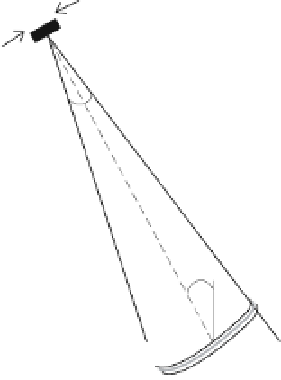Geography Reference
In-Depth Information
imaging of water and flooded land surfaces and retrieval
of meaningful information about flood parameters.
y
Platform motion
Antenna
w
Radar at time
t
6.2.1 Passive radiometry
Passive microwave radiometers measure emitted thermal
radiation (i.e. brightness temperature) in the microwave
region as opposed to active systems such as SAR that
illuminate the target area and record the return signal (or
backscatter). The use of passive microwave systems over
land surfaces is difficult given the large angular beams of
such systems (Rees, 2001) resulting in spatial resolutions
as large as 20 to 100 km. Interpretation of the wide range
of materials with many different emissivities (emissivity
is defined as the efficiency of an object to radiate energy
at a certain frequency compared to a blackbody which
is a perfect absorber and emitter of all electromagnetic
radiation) within the beam ground footprint is thus
rendered nearly impossible.
Nevertheless, as such instruments are sensitive to chan-
ges in the dielectric constant, very large areas of water
can be detected; water has a very high dielectric constant
whereas most dry materials have a very low dielectric
constant (see section 6.2.2). Both Sippel et al. (1998)
and Jin et al. (1999) show that areal flood estimates
can be obtained from changes in brightness tempera-
ture captured by passive radiometers. Sippel et al. (1998)
used flood areas derived from brightness temperature
changes in the Amazon River floodplain to reliably con-
struct an area-stage relation (R
2
y
s
H
q
Scatterer
x
Figure 6.1
Simple geometry for considering SAR imaging. At
time t, the radar is at (vt, H, 0) and a scatterer has the fixed
coordinates (x, 0, 0). The figure illustrates a side looking
geometry where the slant range (line-of-sight distance) s equals
H/cos
θ
ψ
λ
and the radar beam of angular width
is given by
/w.
At different stages in t, while the sensor moves forward, the
relative position of the scatterer will change and therefore
produce a Doppler shift in the return signal. As both the
amplitude and phase of the coherent signal are stored, any
desired value of x can be resolved by extracting the component
of the return signal that has the right variation of frequency
with time (Rees, 2001).
waveforms received successively at the different antenna
positions. These distinctive coherent signal variations are
stored and then post-processed together to resolve fine
resolution image elements.
Surface roughness, which determines the angular dis-
tribution of surface scattering, is considered the main
factor affecting SAR backscattering, whereas the dielectric
properties of an illuminated target significantly control
the penetration depth and therefore the intensity of the
signal. The average relative dielectric constant or rel-
ative permittivity describes the response of a material
to the electric field of the signal (Ulaby et al., 1986,
Raney, 1998). In the microwave domain, most natural
dry materials have a low value of the dielectric con-
stant (dimensionless, 3-8) whereas metals and materials
with increased water content have much higher values,
e.g. water has a value of approximately 80. In principle,
increasing moisture content leads to a stronger reflectivity
and an enhanced surface scattering. In contrast, higher
permittivity increases diffuse volume scattering, which
appears within dielectrically discontinuous media such as
vegetation. For mapping purposes this means that, for
pixels going through a wetting phase or experiencing a
=
.
87) from altimetry-
and field-based water stages. However, the uncertainty
in flood area estimation can be large. Papa et al. (2006)
highlight considerable disagreement in flood area estima-
tion between passive radiometry, altimetry and climate
research datasets in the order of 0.3 to 0
0
10
6
km
2
.
Another problem with area-stage relationships is that a
large number of images showing different flood extents
needs to be available to construct reliable and extrapola-
tive functions (Smith et al., 1997).
.
7
×
6.2.2 SyntheticApertureRadar
Although at the detailed level the operation of a syn-
thetic aperture radar (SAR) system is quite complex, it
suffices to say that SAR is an advanced form of a side-
looking radar system (Figure 6.1) with a manageable size
antenna that employs the Doppler shift principle to syn-
thetically obtain finer spatial resolution than is possible
with conventional beam-scanning mechanisms. While in
motion, the system repeatedly illuminates a target scene
with pulses of microwaves and coherently detects the




Search WWH ::

Custom Search